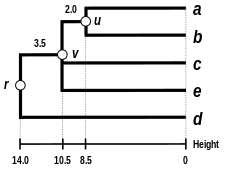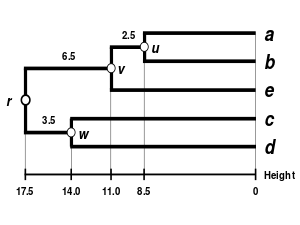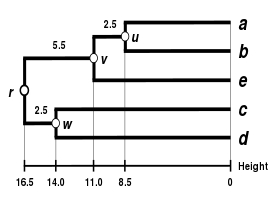WPGMA (Weighted Pair Group Method with Arithmetic Mean) is a simple agglomerative (bottom-up) hierarchical clustering method, generally attributed to Sokal and Michener.
The WPGMA method is similar to its unweighted variant, the UPGMA method.
Algorithm
The WPGMA algorithm constructs a rooted tree (dendrogram) that reflects the structure present in a pairwise distance matrix (or a similarity matrix). At each step, the nearest two clusters, say  and
and  , are combined into a higher-level cluster
, are combined into a higher-level cluster  . Then, its distance to another cluster
. Then, its distance to another cluster  is simply the arithmetic mean of the average distances between members of
is simply the arithmetic mean of the average distances between members of  and
and  and
and  and
and  :
:

The WPGMA algorithm produces rooted dendrograms and requires a constant-rate assumption: it produces an ultrametric tree in which the distances from the root to every branch tip are equal. This ultrametricity assumption is called the molecular clock when the tips involve DNA, RNA and protein data.
Working example
This working example is based on a JC69 genetic distance matrix computed from the 5S ribosomal RNA sequence alignment of five bacteria: Bacillus subtilis ( ), Bacillus stearothermophilus (
), Bacillus stearothermophilus ( ), Lactobacillus viridescens (
), Lactobacillus viridescens ( ), Acholeplasma modicum (
), Acholeplasma modicum ( ), and Micrococcus luteus (
), and Micrococcus luteus ( ).
).
First step
Let us assume that we have five elements  and the following matrix
and the following matrix  of pairwise distances between them :
of pairwise distances between them :
|
|
a
|
b
|
c
|
d
|
e
|
| a
|
0 |
17 |
21 |
31 |
23
|
| b
|
17 |
0 |
30 |
34 |
21
|
| c
|
21 |
30 |
0 |
28 |
39
|
| d
|
31 |
34 |
28 |
0 |
43
|
| e
|
23 |
21 |
39 |
43 |
0
|
In this example,  is the smallest value of
is the smallest value of  , so we join elements
, so we join elements  and
and  .
.
- First branch length estimation
Let  denote the node to which
denote the node to which  and
and  are now connected. Setting
are now connected. Setting  ensures that elements
ensures that elements  and
and  are equidistant from
are equidistant from  . This corresponds to the expectation of the ultrametricity hypothesis.
The branches joining
. This corresponds to the expectation of the ultrametricity hypothesis.
The branches joining  and
and  to
to  then have lengths
then have lengths  (see the final dendrogram)
(see the final dendrogram)
- First distance matrix update
We then proceed to update the initial distance matrix  into a new distance matrix
into a new distance matrix  (see below), reduced in size by one row and one column because of the clustering of
(see below), reduced in size by one row and one column because of the clustering of  with
with  .
Bold values in
.
Bold values in  correspond to the new distances, calculated by averaging distances between each element of the first cluster
correspond to the new distances, calculated by averaging distances between each element of the first cluster  and each of the remaining elements:
and each of the remaining elements:



Italicized values in  are not affected by the matrix update as they correspond to distances between elements not involved in the first cluster.
are not affected by the matrix update as they correspond to distances between elements not involved in the first cluster.
Second step
We now reiterate the three previous steps, starting from the new distance matrix  :
:
|
|
(a,b)
|
c
|
d
|
e
|
| (a,b)
|
0 |
25.5 |
32.5 |
22
|
| c
|
25.5 |
0 |
28 |
39
|
| d
|
32.5 |
28 |
0 |
43
|
| e
|
22 |
39 |
43 |
0
|
Here,  is the smallest value of
is the smallest value of  , so we join cluster
, so we join cluster  and element
and element  .
.
- Second branch length estimation
Let  denote the node to which
denote the node to which  and
and  are now connected. Because of the ultrametricity constraint, the branches joining
are now connected. Because of the ultrametricity constraint, the branches joining  or
or  to
to  , and
, and  to
to  are equal and have the following length:
are equal and have the following length:

We deduce the missing branch length:
 (see the final dendrogram)
(see the final dendrogram)
- Second distance matrix update
We then proceed to update the  matrix into a new distance matrix
matrix into a new distance matrix  (see below), reduced in size by one row and one column because of the clustering of
(see below), reduced in size by one row and one column because of the clustering of  with
with  :
:

Of note, this average calculation of the new distance does not account for the larger size of the  cluster (two elements) with respect to
cluster (two elements) with respect to  (one element). Similarly:
(one element). Similarly:

The averaging procedure therefore gives differential weight to the initial distances of matrix  . This is the reason why the method is weighted, not with respect to the mathematical procedure but with respect to the initial distances.
. This is the reason why the method is weighted, not with respect to the mathematical procedure but with respect to the initial distances.
Third step
We again reiterate the three previous steps, starting from the updated distance matrix  .
.
|
|
((a,b),e)
|
c
|
d
|
| ((a,b),e)
|
0 |
32.25 |
37.75
|
| c
|
32.25 |
0 |
28
|
| d
|
37.75 |
28 |
0
|
Here,  is the smallest value of
is the smallest value of  , so we join elements
, so we join elements  and
and  .
.
- Third branch length estimation
Let  denote the node to which
denote the node to which  and
and  are now connected.
The branches joining
are now connected.
The branches joining  and
and  to
to  then have lengths
then have lengths  (see the final dendrogram)
(see the final dendrogram)
- Third distance matrix update
There is a single entry to update:

Final step
The final  matrix is:
matrix is:
|
|
((a,b),e)
|
(c,d)
|
| ((a,b),e)
|
0 |
35
|
| (c,d)
|
35 |
0
|
So we join clusters  and
and  .
.
Let  denote the (root) node to which
denote the (root) node to which  and
and  are now connected.
The branches joining
are now connected.
The branches joining  and
and  to
to  then have lengths:
then have lengths:

We deduce the two remaining branch lengths:


The WPGMA dendrogram
The dendrogram is now complete. It is ultrametric because all tips ( to
to  ) are equidistant from
) are equidistant from  :
:

The dendrogram is therefore rooted by  , its deepest node.
, its deepest node.
Comparison with other linkages
Alternative linkage schemes include single linkage clustering, complete linkage clustering, and UPGMA average linkage clustering. Implementing a different linkage is simply a matter of using a different formula to calculate inter-cluster distances during the distance matrix update steps of the above algorithm. Complete linkage clustering avoids a drawback of the alternative single linkage clustering method - the so-called chaining phenomenon, where clusters formed via single linkage clustering may be forced together due to single elements being close to each other, even though many of the elements in each cluster may be very distant to each other. Complete linkage tends to find compact clusters of approximately equal diameters.
See also
|
|
|---|
| Relevant fields |
|
|
| Basic concepts |
|
| Inference methods |
|
| Current topics |
|
| Group traits |
|
| Group types |
|
| Nomenclature |
|
|




































































































